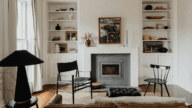What Is a Ranch House? TV’s Nostalgic Home Style Is Still in Demand
- Published on
- 10 min read
-
 Abbey Harris, Contributing AuthorClose
Abbey Harris, Contributing AuthorClose Abbey Harris Contributing Author
Abbey Harris Contributing AuthorAbbey Harris is a writer and communications specialist based in Knoxville. She holds a Bachelor of Arts in English with minors in business and communication, and a Master of Science in communications/public relations from the University of Tennessee, Knoxville. In her spare time, she can be found advising on amateur home decorating and DIY home improvement projects.
-
 Joseph Gordon, EditorClose
Joseph Gordon, EditorClose Joseph Gordon Editor
Joseph Gordon EditorJoseph Gordon is an Editor with HomeLight. He has several years of experience reporting on the commercial real estate and insurance industries.
If you’ve ever watched some of the most beloved sitcoms of the 1970s, 80s, or 90s, you’ve seen a ranch home. Shows like The Golden Girls, The Wonder Years, and perhaps most notably, The Brady Bunch, featured ranch-style homes. But what is a ranch house?
Ranch house styles are one of the most popular home styles in the United States today, across cities and suburbs nationwide.
We looked into the history of ranch homes, studied different styles, perks, and challenges, and talked to top real estate agent Shirley Grindel with Shirley’s Real Estate Group in Washington to find out everything you need to know about this style of home.
A ranch house by any other name
You may know ranch house by its other names: rancher or rambler. There are also several different styles of ranch homes that were built as they grew in popularity over the years.
History of ranch houses
Residential ranch houses first began appearing in the 1920s. Master architect Cliff May is known as the father of the modern ranch house, even though he didn’t design his first home for another decade. Though he didn’t have formal architectural training, he learned his craft on the job and found inspiration in his detailed knowledge of the San Diego region’s Spanish colonial architectural heritage. He based the design style on homes found on Southwestern ranches.
First ranch-style residences
In the 1930s, May designed the first ranch-style residences in San Diego. These homes reflected traditional adobe hacienda architecture, with white stucco walls and red clay tile roofs with wood accents, courtyards, and archways. They also featured designs like those found on homes on Southwestern ranches, which were sprawling estates meant to blend in with the countryside but utilized modern materials and construction techniques, like brick and stone exteriors.
At the time, May’s design was a radical change because it eliminated the steep roofs, porticoes, tables, dormer windows, and front porches that were common for the time. This shift showed that people were moving away from seeing the home as a formal status symbol and recognizing it as a gathering place. Multi-use rooms replaced the separation of formal entertaining spaces with casual living spaces and brought them together.
Height of popularity
Ranch homes became infinitely more popular with the post-war middle class of the 1940s. They were so popular that by the 1950s, nine out of 10 homes built were ranch-style homes. As people began moving into the suburbs after World War II, suburban ranch homes were where the American Dream came to life.
Returning soldiers wanted to move out of their city apartments, own land, and build a different, suburban life for their families. The ease of construction and customizability made ranch homes a trendy option. Because of the war, home-building products were scarce. Hence, the suburban ranch was also the first time companies started mass-producing homes using tract, or mass-produced, materials — meaning they could be more easily and quickly constructed.
Interestingly, even though the homes are quite young, any ranch home built before 1964 is considered historic.
Cycling out
By the 1970s, the popularity of the ranch-style home was fading. Land was getting more expensive and the energy crisis was causing utility prices to rise. The next generation of homeowners started favoring larger homes with more modern designs, as opposed to their parents’ homes.
Renewed interest
The 1990s brought a revival of interest in the rancher that continues today. Young buyers are drawn to them because they can be more affordable in a difficult market, and downsizing older buyers like them because the single-story living makes for easier home navigation as they age.
Most neighborhoods featuring ranch houses are well-established and often feature larger lots and mature, full-grown trees uncommon in new construction developments.
What is a ranch home?
You can think of ranch homes as an extension of bungalow homes, which were popular from 1905-1930. Bungalows are small, one- or one-and-a-half-story homes with quaint front porches and overhanging roofs with visible beams and rafters. Because they were small and relatively inexpensive, bungalows offered many working-class families the first chance at homeownership.
A traditional ranch home is a single-story house with a long, low-pitched, extended eave roof and a mix of exterior materials — usually stucco, wood, brick, or stone. They feature an open-concept living space with post and beam ceilings, sliding glass doors, picture windows, centrally located fireplaces, large kitchen islands, and patios.
The size of the home depends largely on when it was built, but the earliest ranch homes typically had three bedrooms and one bathroom and averaged around 1,300 square feet. Now, homes in this style typically range from between 1,100 to 1,500 square feet.
While these homes can be found all over the country, they are particularly trendy in the Southwest and less common on the East Coast, primarily due to their San Diego origins.
Though most ranch homes share common features, there are several types of ranch homes of which to be aware.
California ranch
California has a rich landscape, and these homes were sprawling and seamlessly blended into that. The California ranch has an L- or U-shaped design with a middle courtyard borrowed from the Arts and Crafts movement. It often utilizes Spanish Colonial architecture, including flat roofs and local materials. This style promotes an easy transition between indoor and outdoor space and provides more light throughout the house.
Suburban ranch
These homes are built on concrete slabs, a fairly common house foundation because it requires the least amount of lot prep to begin construction. It uses tract material and incorporates attached garages. Suburban ranch homes utilize many of the same features as the California Ranch, such as the use of low-to-the-ground framework and courtyards, but are smaller and more simply designed without the red clay tile roofs and stucco siding.
Split-level ranch
The split-level ranch is the type of ranch home the Bradys lived in. They look like your standard ranch from the outside, but inside, they feature multiple — usually three or four — split levels of living. The front door leads to the living area, dining room, and kitchen on the main level. Short flights of stairs will lead you up to the bedrooms or down to a den, basement, and garage.
Raised ranch
With only two levels, raised ranches are what are commonly identified today as split-foyer homes, whereupon entering the foyer through the front door, you must go upstairs to the living room, kitchen, and bedrooms, or downstairs to the den, garage, and storage areas. Often, these homes could be built into a hill and have as much as half a level below the ground.
Storybook ranch
Also called a Cinderella ranch, the storybook ranch is the most modern style. They use a more charming exterior design with steep gabled roofs, specialty windows, ornamental trim, decorative brick or stone chimneys, and exposed rafters. Some consider them over-the-top, and they often didn’t garner the same prestige as other styles.
Pros and cons of ranch homes
Though we’ve briefly mentioned some of the pros and cons of ranch homes, let’s explore them further below.
Great alternative to two-story living
Ranch-style homes are great for families with young children or older homeowners who no longer want to navigate two-story living because you don’t have to worry so much about stairs.
Lower maintenance and repair costs
“Maintenance is going to be a little easier,” says Grindel. This is because the low-pitch roofs on a ranch-style home provide easy access to gutters and windows. This helps with the cost of exterior cleaning (when those pesky leaves start to fall) or upgrading (because contractors won’t have to risk their lives climbing two stories on a ladder to patch your roof). It also simplifies tasks like installing holiday decor.
Remodel options
Ranch homes are easy to remodel or expand because most interior walls aren’t load-bearing, making them incredibly customizable for desired upgrades.
In July 2018, the Brady Bunch house went on sale for the first time in nearly 50 years, igniting a high-profile bidding war, which HGTV ultimately won.
Situated in Studio City, the iconic home features 5,140 square feet over two floors, five bedrooms, and five bathrooms. They purchased the property for $3.5 million in August 2018, a significant increase from the initial $1.885 million asking price.
Today, the Wall Street Journal reports that the house has been sold to Tina Trahan, a dedicated fan of the show and the wife of former HBO chief executive Chris Albrecht, for $3.2 million. This sale is $2.3 million lower than the $5.5 million asking price set by HGTV when the home was listed in May.
Endless entertainment options
The ranch house’s open floor plan means that more of the home can be utilized for events, and guests can move more freely through your space. Fewer walls mean that even as people move happily from room to room, everyone feels connected, not separated.
But somehow, people almost always seem to gather in the kitchen, so the kitchen island can be great for buffet-style gatherings and parties, making it easier for people to grab and fill their plates and meander to the super inviting patio.
Transitional space
Because ranch homes commonly utilize sliding glass doors and large picture windows, you’ll feel like you’re one with nature because the transition between the two spaces is fluid. Outdoor living space is a hot commodity.
According to a Statista report, in 2021, the American barbecue grill market was valued at approximately $2.75 billion, up from $2.19 billion in 2015. A recent Global Market Insights Inc. study predicts that the barbecue grill market will reach around $8.3 billion by 2032.
Patio renovations and upgrades can bring a significant return on investment, so enhancing your space will not only help with the flow of your house but can also bolster your bottom line.
“The ROI is there with any outdoor entertaining area,” Grindel says.
Not ideal for colder temperatures
If you’re not into winter home maintenance, a ranch-style home may not be for you. Low-pitched roofs that make for easy maintenance also don’t drain well. In rainy seasons, that can lead to leaks. In snowy seasons, it can lead to ice buildup on lower edges.
Some ranch homes are also harder to heat because some areas are much further from the heating units than others, and the sliding doors and picture windows are prone to drafts.
Of course, these issues can be solved with proper winterization and energy-efficient improvements like sealing windows and doors.
Buying a ranch home
According to Grindel, “Long term and over time, ranch homes are an awesome investment,” because they’re great for multiple family types, easily customizable, and have incredible potential for return on investment.
If you can picture your family entertaining like the Bradys did (with a modern twist, of course!), and think a ranch house is a good fit, find a good agent to help you navigate the process and find the perfect home.
Header Image Source: (karamysh / Shutterstock)
- "Open Floor Plan: History, Pros and Cons", The Spruce (November 2023)
- "After months on the market, 'The Brady Bunch' house sells for $3.2 million," NPR, Vanessa Romo (September 2023)
- "What Is A Bungalow? A Complete Guide", Quicken Loans (May 2023)
- "Everything to Know About Rambler or Ranch-Style Homes", Angi (February 2022)
- "Top 3 Most Popular House Styles", America’s Best House Plans(August 2023)




